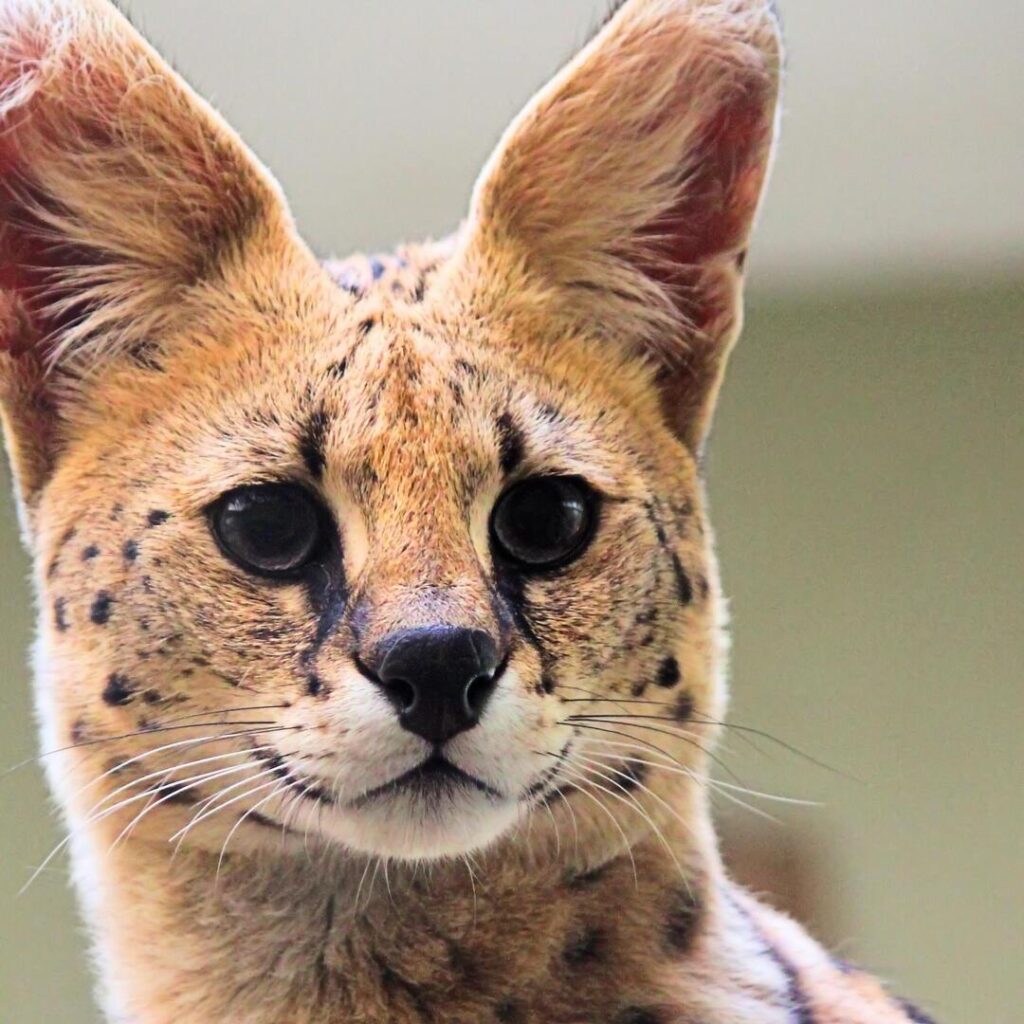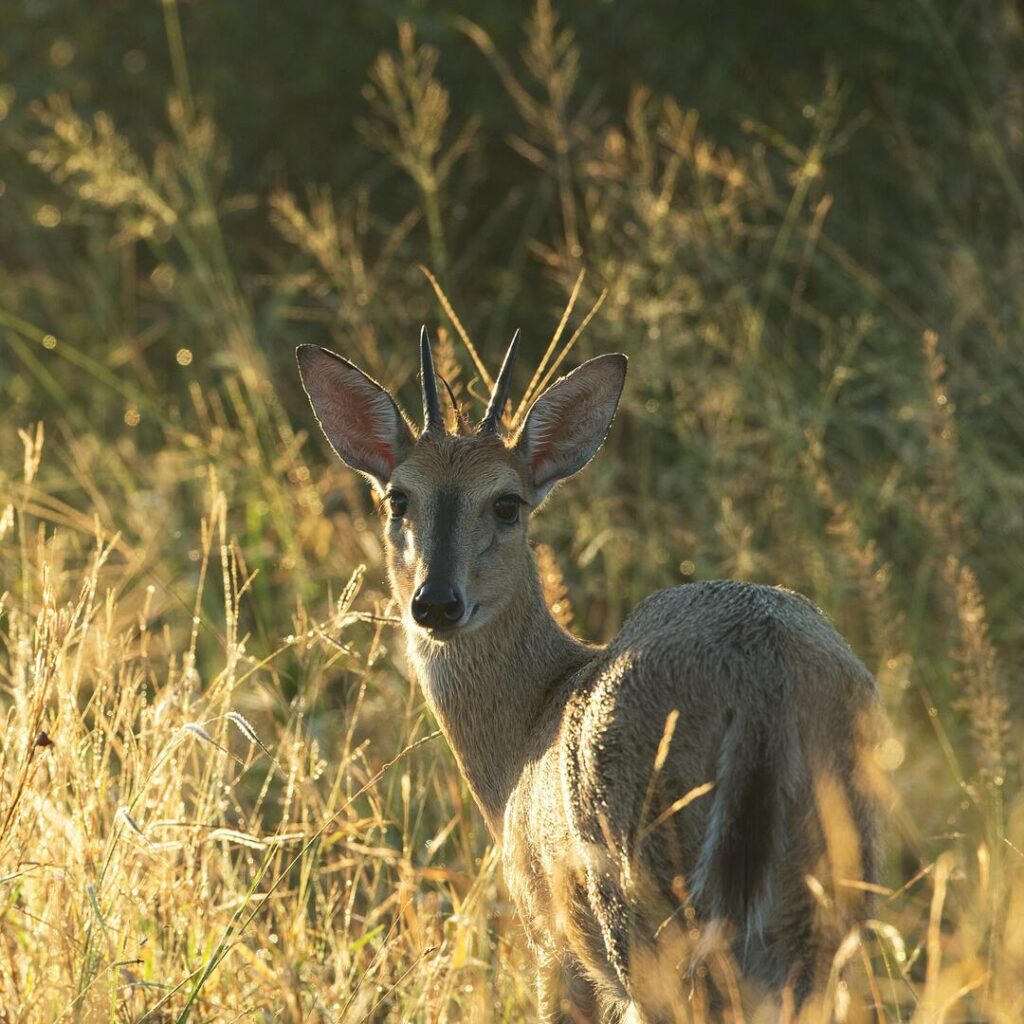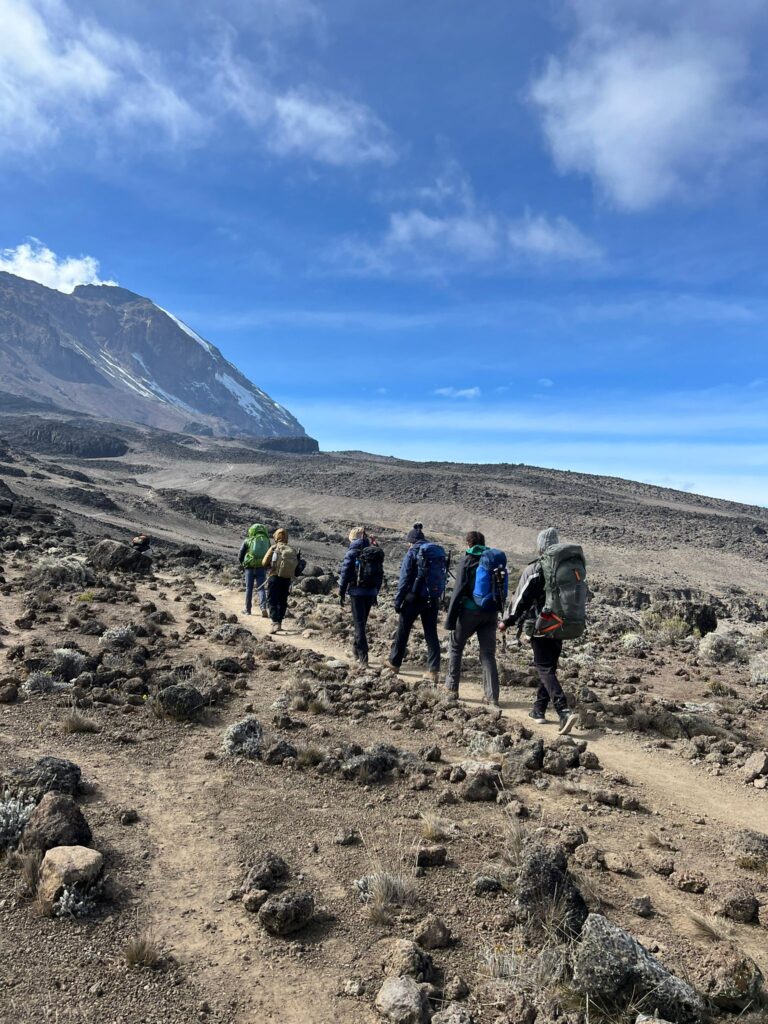Unique African Wildlife On Kilimanjaro, Tanzania
The teeming wildlife within Kilimanjaro National Park covers an impressive variety of species, such as mammal recordings of 154 species, with seven primate species and hundreds of bird species. While large mammals like elephants, giraffes, and cape buffalo have been spotted, they typically maintain their distance from humans and seek refuge in the dense rainforest. Although game spotting is not the main focus for most visitors at Kilimanjaro National Park, there are still opportunities to encounter common animals during a climb or a safari. However, for those specifically interested in observing large African mammals, like the Big Five, it is recommended to embark on a Tanzania safari in renowned national parks such as Ngorongoro Crater or the Serengeti, which offer an abundant game, a variety of predators, and the spectacular Great Wildebeest Migration.
Nonetheless, even during a trek up Mount Kilimanjaro, climbers are likely to come across intriguing wildlife. The Rongai route, in particular, offers better chances of spotting elephants as it traverses the northern side of the mountain where they are more commonly seen. Throughout Kilimanjaro treks, various monkeys, antelope, exotic cats, and highland animals can be seen. The lower slopes, with their lush tropical rainforests, support more animal diversity compared to the higher elevations due to the availability of water and food. It is important to note that all animals encountered on Kilimanjaro are wild, as they freely roam within the national parks of Tanzania. While dangerous predators like lions are not encountered during the climb, climbers may come across shy species of antelope like Abbott’s Duiker or chattering monkeys, honey badgers, aardvarks, or porcupines in their natural habitat. However, as mentioned earlier, to truly immerse yourself in Tanzania’s diverse wildlife, the ultimate way is through an African safari in one of the country’s renowned national parks.
Mount Kilimanjaro National Park is a sprawling ecosystem covering an area of 1,688 square kilometers (652 square miles) and has a rich history of protection. The park was initially established as a forest reserve in 1921, then later gained the status of a national park in 1973, before it was designated as a UNESCO World Heritage Site in 1987. This conservation effort has effectively shielded the wildlife within the Kilimanjaro area from human encroachment. The majority of the park is situated in the Montane forest belt, which supports a diverse range of ecological zones that include bushland, rainforest, heath, alpine desert, and arctic regions. As climbers ascend to the summit, the availability of resources such as plants, insects, and water diminishes, resulting in a decline in wildlife populations in various climactic zones.
What Animals Live On Mount Kilimanjaro?
- Mammals — Rare sightings of large mammals such as elephants, buffaloes, and the Kilimanjaro giraffe have been reported along the Rongai route. However, during your Kilimanjaro hike, you’re more likely to encounter smaller yet unique mammals like colobus monkeys, blue monkeys, serval cats, tree hyraxes, duikers, white-tailed mongoose, marsh mongoose, four-striped mice, and aardvarks. The scarcity of appropriate resources on Mount Kilimanjaro prevents the support of large mammals in the area.
- Birds — Kilimanjaro National Park is renowned for its diverse avian population, boasting over 150 bird species. Among the notable feathered inhabitants are white-necked ravens, malachite sunbirds, kingfishers, African pittas, and the rare Abbott’s starling. Throughout the day, their melodious songs resonate, and in the afternoons, you can expect frequent visits from these captivating creatures during your camp stay. Unlike the mammalian residents, the birds will undoubtedly captivate your senses as you embark on your trek up Mount Kilimanjaro, ensuring an abundance of avian encounters along the way.
- Reptiles — During your hike up Mount Kilimanjaro, the reptiles you are likely to come across are Jackson’s chameleons and Dwarf Fischer’s chameleons. These reptiles can be found specifically on the lower slopes of the mountain and are native to East Africa exclusively.
Species – Mammals Of Kilimanjaro National Park
What mammals will I see while climbing Kilimanjaro?
1. Serval Cat

The Serval Cat is a medium-sized wild cat with tawny-colored fur and black spots all over its body. The cat is indigenous to sub-Saharan Africa, including Tanzania. While the media often focuses on big cats like lions and leopards, there are other ‘big cats’ to be found in Tanzania, such as the Serval Cat. Resembling a cheetah in coloration but smaller and more slender, the Serval Cat stands out with its long legs and large ears, complemented by a striking pattern of black stripes and spots on its body (1). This solitary creature hunts day and night, preying on small rodents, birds, frogs, insects, and even reptiles, while displaying its versatile diet that includes grass as well.
With a jumping ability of up to 1.5 meters (4.9 feet), Serval Cats often pounce on their prey, swiftly delivering a fatal bite to the neck or head. If your trekking group maintains a peaceful atmosphere during your ascent of Mount Kilimanjaro, you might be fortunate enough to catch a glimpse of this elusive Serval Cat slinking through the moorlands and bamboo thickets, as it roams at altitudes of up to 3,800 meters (12,500 feet).
2. Galago

Galagos, also known as Bush babies or nagapies, are nocturnal creatures with big, round eyes that provide excellent night vision. They have a brownish grey to light brown coat and are highly agile, leaping far distances from tree to tree. As omnivores, their diet consists of small birds, insects like grasshoppers and moths, as well as other small animals, fruit, and tree gums obtained using their sharp toothcombs. These adorable primates live in tree hollows for shelter and are commonly found in the woods of Kilimanjaro.
Despite being fairly common, they are difficult to spot due to their nocturnal behavior. Climbing Kilimanjaro offers a chance to encounter these elusive creatures along the way, making it an exciting bonus to the adventure. Additionally, as a rewarding experience after summiting Kilimanjaro, one can enjoy an epic Tanzania safari, where you’ll also come across these creatures. Galagos have endearing features such as large eyes, big ears, and bushy tails, but their shy nature makes them elusive to observers. In the cultivated zone near or above, they can be heard jumping on hut roofs during the night (1). Being nocturnal animals, these tiny primates resemble plush toys with their fluffy fur and are challenging to spot during the daytime, adding an element of excitement to visits to Kilimanjaro.
3. Aardvark

The Aardvark is an animal unique to Sub-Saharan Africa, which has captured our fascination, despite its resemblance to a pig. Although its name is derived from the Afrikaans word for “ground pig”, it is surprisingly related to one of Africa’s beloved mammals; the majestic elephant. Even though their ears and snout may not mirror those of an elephant, we trust in the realm of science (1). Nocturnal by nature, Aardvarks wisely evade the scorching sun during the day, only to emerge at night in search of ants and termites.
These intriguing creatures have been observed embarking on long journeys to discover the perfect termite mound and employing their elongated snouts to reach these minuscule insects.
4. Black-And-White Colobus Monkey

The Colobus Monkey, derived from the Greek word “kolobos” meaning maimed or mutilated, lacks thumbs due to its adaptation for arboreal living. Its hook-like fingers enable efficient swinging among the forest canopy. As Colobus Monkeys age, they undergo a remarkable transformation from being completely white at birth to displaying an unusual black and white appearance in adulthood. Their most striking feature is their fluffy white tails, measuring two feet long. These monkeys can be found near the Kilimanjaro trailheads and throughout the rainforest section, where they primarily consume leaves, fruits, and flowers.
The Black-and-White Colobus Monkeys possess ruminant-like stomachs with three chambers, aiding in the digestion of leaves. These monkeys reside in family groups high in the trees (1), and if one is spotted, there is likely a sibling nearby. They can be recognized by the distinctive loud chattering noise they make during the day and occasionally at night. The Colobus Monkey in Tanzania belongs to the “guereza primates” family and the population on Mount Kilimanjaro is endangered, making it essential to observe them without disturbance. Along the slopes of Mount Kilimanjaro, Colobus monkeys are relatively common, especially the black and white species, which are shyer around humans compared to blue monkeys. Mountaineers have the best chances of encountering colobus monkeys near the Mandara Huts, around the Marangu route, as well as at the start of the Rongai, Umbwe and Shira/Lemosho routes, heading up Mount Kilimanjaro.
5. Abbott’s Duiker

The Abbott’s Duiker is a small, endangered species of antelope that can be found in a few remaining locations in Tanzania, including the Udzungwa Mountains and Mount Kilimanjaro. It is a type of duiker, which is known for its ability to dive into the bushes to evade predators (1). Duikers are smaller than typical grassland antelopes and have distinct-shaped horns and a hump on their back. They inhabit heavily wooded areas, making them unlikely to be seen on a traditional safari through the savannah. The decline of the Abbott’s Duiker is primarily attributed to the loss of their natural habitat and the impact of deforestation on their food sources rather than predation.
The wildlife of Tanzania, including the duiker species, is facing increasing risks. On Mount Kilimanjaro and its surrounding forests, the Duiker antelope is the most renowned species among the antelopes and is significantly smaller, weighing between 3 kg (6.5 lb.) and 70 kg (150 lb.), compared to other antelopes in the region. The name “duiker” comes from the Dutch word meaning “to dive,” which accurately describes the antelope’s agile movements between rocks. Duiker antelopes are herbivores, feeding on leaves, seeds, tree bark, and occasionally dropped fruits. They are active during both day and night, allowing mountaineers and tourists to sometimes spot them in the area.
6. Blue Monkey

The Blue Monkey, also known as the Diademed Monkey, can be found in Kilimanjaro’s rainforest, particularly around Big Forest Camp, which is the first campsite on the Lemosho Route. The name is misleading because these primates aren’t especially blue. The body is gray and olive in color, with patches of white and black, while their face is darker with some yellow or paler patches on the forehead. Their eyes have a distinct reddish-brown hue that stand out in dark places, since these monkeys primarily inhabit tall trees, which provide both food and shelter.
Blue Monkeys of Tanzania mainly consume fruits and figs, but also feed on insects, leaves, twigs, and flowers (1). During your ascent and descent through the forest zone, keep an eye out for these primates, as they are not shy around humans and are therefore relatively easy to spot. These primates are quite common and unfazed by people. A significant number of them can be found around the Mandara Huts, on the Marangu route, hence the name “monkey forest” for the forest patch above the Mandara Huts. An encounter with a blue monkey is likely to be the most exciting wildlife sighting of your Kilimanjaro trek because most species are shy and steer clear from human interactions. Similar to the four-striped grass mouse of Horombo, the Blue Monkey is one of the few species that have benefited from the arrival of humans. One thing that many people are unaware of is that the blue monkey is actually the less striking counterpart of the beautiful colobus monkey, which you may also have the opportunity to photograph during your trek up the mountain.
7. Tree Hyrax

The small, nimble Tree Hyrax is an animal that can be found on Mount Kilimanjaro. These agile creatures inhabit the forested areas, where they live amongst trees. This is because the lower forests of Kilimanjaro serve as their natural habitat. In the early evening and at nighttime, you may hear the distinct ‘call’ of the Tree Hyrax, ranging from a cackle to a loud shriek, as they mark their territory (1). To spot these special creatures, careful attention after dark is required. Interestingly, Tree Hyraxes, also known as Tree Dassies in Afrikaans, are more common sightings than most mammals on Mount Kilimanjaro and their screeches can sometimes be heard from camp.
Despite their small size, similar to rabbits, these small nocturnal animals are distantly related to Elephants and Manatees (sea cows).
8. Marsh Mongoose

The Marsh Mongoose, which belongs to the mongoose family, is smaller than its white-tailed sibling (1). It displays a unique hunting behavior in which it poses as if sunbathing, exposing its belly and buttocks skyward, before attacking its prey when they come near. The pink flesh against its fur especially attracts birds, allowing the swift mongoose to capture its prey, before it takes flight. They are primarily carnivorous, feeding on birds, small mammals, reptiles, and eggs. Known for their audacious attacks on venomous snakes, they are formidable creatures in this unique ecosystem.
The Mongoose is a common sight around Mount Kilimanjaro, residing in the surrounding savannahs and forests. With short legs and long furry tails resembling otters, mongooses are easily recognized by tourists. Hikers on Kilimanjaro trails may easily spot this mammal if they tread quietly.
9. White-Tailed Mongoose

The White-Tailed Mongoose is a nocturnal mammal native to Africa that bears a resemblance to the body type of a weasel. Among the various mongoose species, the white-tailed mongoose is most renowned for its ability to take down large venomous snakes, as depicted in numerous YouTube videos (1). Being the largest member of the mongoose family, the white-tailed mongoose has a brown-colored body for camouflage in wooded areas, however what sets it apart from other mongooses is its long, fluffy white tail.
Similar to a skunk when startled, the mongoose can release a musky odor from a gland in its rear end, so caution is advised when coming across these creatures. It’s interesting to note that, unlike other wildlife that inhabits Mount Kilimanjaro, White-Tailed Mongooses are commonly spotted on the mountain.
10. Four Striped Grass Mouse

Wherever humans reside, rodents are almost always present, including various species of mice. Among them is the Four Striped Grass Mouse, which is slightly larger than house mice but resembles chipmunks with their appearance (1). This species displays four black stripes along its back and exhibits unique behavioral patterns. They are more active during the mornings and late afternoons while resting during midday.
Despite living in groups, these mice are solitary foragers and can be found at Kilimanjaro’s campsites and huts, which serve as their preferred habitats, due to abundant food sources. As omnivores, their diet consists of a wide range of green plants, seeds, invertebrates, and human scraps. Above the treeline, sightings of animals are rare, but the four-striped grass mouse defies this trend on the mountain. This diminutive creature thrives at high altitudes, effortlessly surviving in cold environments like the Barranco Valley. In fact, you might spot one scurrying under your table at breakfast or dinner during the expedition. Other rodents in this region, such as the harsh-furred mouse, climbing mouse, and mole rat are far more challenging to spot, in comparison to the Four Striped Grass Mouse. These small, four-legged animals can also be found in the savannahs surrounding Mount Kilimanjaro and the arid desert areas adjacent to the mountain.
Species – Reptiles Of Kilimanjaro National Park
What reptiles will I see while hiking Kilimanjaro?
1. Kinyongia Tavetana (Dwarf Fischer’s Chameleon) & Jackson’s Chameleon

Chameleons are a type of lizard primarily found in Africa. These remarkable creatures are known for their ability to change skin color in response to emotions, variations in light, temperature, and humidity. With independent eye movement, chameleons possess unique vision and can attack insects with remarkable accuracy by rapidly extending their tongues to twice their body length.
On Mount Kilimanjaro, you can encounter the three-horned Jackson’s chameleon and the slightly smaller Kilimanjaro two-horned chameleon, which is also known as the Dwarf Fischer’s chameleon. Additionally, Jackson’s chameleons thrive in cool and humid climates and are insectivores, with a diverse diet consisting of worms, cockroaches, crickets, flies, and even snails, which they have been seen swallowing whole, including the shell.
2. Puff Adder

The Puff Adder (Bitis arietans) belongs to the family Viperidae and is a master of camouflage, seamlessly blending with mottled leaves and dry grass in savanna areas. The body of the Puff Adder is adorned with well-patterned light chevrons, exhibiting a range of colors from yellow to dull brown. Typically, adults of this species average 70-110 cm (2-3 feet) in length and are robust and heavy. However, an exceptionally large female captured in Lolldaiga Hills, Kenya, measured an impressive 185 cm (6 feet) in length.
Puff Adders feed on various types of mammals, birds, lizards, and toads, with reports even documenting their predation on Dik-diks and small tortoises. As a venomous snake, it possesses long fangs that can measure up to 2cm in length and once they strike their prey, they release it and skillfully use their tongues to track the scent of its trail. That’s because the potent cytotoxic venom quickly incapacitates their prey, causing severe swelling and tissue damage. Although bites from this species are widespread throughout Africa, they are unheard of on Mount Kilimanjaro.
3. Eastern Green Mamba

The Green Mamba (Dendroaspis angusticeps), also known as the Eastern Green Mamba, Common Mamba, or White Mouthed Mamba, is a venomous arboreal snake belonging to the Elapidae family. Females are typically longer than males, with an average length of 2 meters (6.6 feet) compared to 1.8 meters (5.9 feet) found in males. These snakes have elongated heads, slender bodies, and medium to moderately long tapering tails.
Their relatively long fangs can rotate on their axis thanks to the prefrontal bone, which provides enhanced control over their movement. The Green Mamba’s dorsal scales are bright green, while the ventral scales are pale green, occasionally interspersed with scattered yellow scales along their flanks. Preying on birds, eggs, bats, lizards, and various rodents, this elusive and shy snake spends most of its time in trees and dense shrubs, relying on its green coloration for camouflage. While they primarily remain above ground, unless motivated by thirst, prey, or sunbathing, they can reach speeds of up to 7 mph. Unlike their larger and more aggressive relative, the black mamba, Green Mambas avoid confrontation with humans and other potential predators by utilizing their camouflage or swiftly slithering away. These diurnal snakes typically seek shelter in leafy clumps or occasional tree hollows during the night.
4. Boomslang

The Boomslang (Dispholidus typus) is a venomous, arboreal snake belonging to the family Colubridae. Its common name, derived from Afrikaans and Dutch, means “tree snake” (boom meaning “tree” and slang meaning “snake”). Ranging from 100-160 cm (3 1/4-5 1/4 feet) in length, with some specimens exceeding 210 cm (6 feet), these snakes are relatively lightweight, weighing only 175-510 g (.386-1.124 lbs).
They possess an egg-shaped head and large, well-developed eyes that provide excellent eyesight. Male Boomslangs display shades of green with black or blue scale edges, while females are mainly brown in color. Juveniles, measuring under 80 cm, exhibit a brown body, a white chin, and large emerald green eyes. By nature, Boomslangs are reclusive and tend to flee from prey too large to consume. During colder periods, they may seek refuge inside closed nests of weaver birds for hibernation. Their diet primarily consists of chameleons, tree lizards, fledgling birds, and frogs. Occasionally, they consume small mammals, birds, and eggs, which are swallowed whole. While many venomous snakes of the Colubridae family are harmless to humans, due to small venom glands and inefficient fangs, the Boomslang is a notable exception. It produces hemotoxic venom and possesses substantial fangs located at the back of its jaw. When striking, the Boomslang can open its mouth up to 170 degrees. Fortunately, these Kilimanjaro snakes are timid by nature, and bites rarely occur unless provoked through handling, catching, or cornering the animal.
5. Eastern Vine Snake

The Vine Snake, scientifically known as Thelotornis mossambicanus or Eastern Vine Snake, belongs to the family Colubridae. These snakes possess slender, elongated bodies, long heads with pointed snouts, and lengthy tails. They are characterized by their horizontal, keyhole-shaped pupils that grant them binocular vision. On average, Vine Snakes measure between 90 to 130 cm (3-4 feet) in length.
6. Twig Snake

Twig snakes, with their greyish-brown coloration and subtle light and dark markings, blend seamlessly into camouflaged vegetation. The upper part of their heads displays a green hue, and when disturbed, they often slowly extend a bright red tongue. While they typically hide in trees, they position themselves low enough to strike at terrestrial prey. Their diet primarily consists of frogs, lizards, and birds, which they consume by swallowing them whole.
These shy snakes, thankfully, tend to avoid humans, and incidents of snake bites are exceedingly rare. The venom they possess is a highly potent hemotoxic substance that can destructively affect red blood cells.
7. Forest Cobra

The Forest Cobra, also known as the Brown Forest Cobra (Naja Subfulva), is a prominent cobra species found in Africa. It is one of the largest cobras on the continent, reaching lengths of up to 2.7m (8 feet) with an average size of 140-220 cm (4-7 feet). These cobras display a glossy brown or black coloration with a black tail and a yellowish-brown shade on the front half. Cream or white hues adorn their chin, throat, and anterior belly region.
The Brown Forest Cobra thrives in various habitats such as coastal forests, woodlands, and montane forests. While primarily terrestrial, it demonstrates climbing and swimming abilities, making it one of the most aquatic cobras known to man. Their diet consists of a diverse range of prey, including small mammals, amphibians, birds, lizards, and other snakes. Although generally shy, these cobras will adopt a defensive posture if threatened, standing tall, spreading a narrow hood, and hissing. It is crucial to heed their warning, as a bite from this snake can be life-threatening, due to its potent venom. Nevertheless, Brown Forest Cobras typically avoid human encounters, preferring to retreat into dense vegetation.
Species – Birds Of Kilimanjaro National Park
What birds will I see while trekking Kilimanjaro?
1. White-Necked Raven

The White Necked Raven, named for the white band on its neck feathers, is a highly intelligent bird, known to possess abstract reasoning, problem-solving skills, and group decision-making abilities, surpassing the cognitive capabilities of a seven-year-old human (1). These omnivorous birds have a varied diet consisting of fruits, grains, insects, carrion, small mammals, reptiles, and even human food. At campsites, one can observe these large, squawking birds of Kilimanjaro flapping around, eagerly scavenging for food. They are notorious for breaking into a hiker’s unattended daypack or bag in search of goodies.
You can find these intelligent birds often enjoying their loot perched atop trees, especially as climbers ascend to higher altitudes, at Kilimanjaro’s moorland campsites, where the wildlife population diminishes. White-necked ravens have a distinctive appearance, featuring a white nape and beak tip. Throughout the climb, mountaineers and avid bird watchers can revel in the sight of these majestic black-feathered creatures soaring and nesting along the rugged slopes of Mount Kilimanjaro, particularly during day-time hiking trips.
2. Malachite Sunbird

Sunbirds, including the Malachite Sunbird, are plentiful on Kilimanjaro, specifically in the heath and moorland areas, where lobelias and proteas grow. If you choose to climb on the Northern Circuit, Shira, Machame, or Lemosho Route, you will have a particularly good chance of seeing them in the Karanga Valley (1). However, it’s worth noting that you may also spot these sunbirds on Mt. Meru or during a safari in Tanzania. Except for a small scarlet patch on either side of its chest, the Malachite Sunbird is a beautiful bird with a metallic green color.
This delightful bird can be seen hovering above the grass, using its long beak to reach nectar from flowers or sometimes even feeding on giant lobelias.
3. Silvery-Cheeked Hornbill

The silvery-cheeked hornbill is a rather large bird that can be found in the forest, as well as in houses, plantations, and fruit trees since it particularly enjoys eating fruit. These magnificent birds can be spotted not only on Kilimanjaro but also on the grounds of your hotel. Alongside them, you’ll also be able to spot speckled mousebirds which also frequent forest fruit trees, especially fig trees in particular.
4. Alpine Chat

The alpine chat is a small brown bird with distinctive white side feathers in its tail. The bird belongs to the Old World flycatcher family, which thrives at high altitudes on moorland and grassland, typically above 3,400 m (11,100 ft) but occasionally as low as 2,100 m (6,900 ft). With its short tail and long legs, this bird displays bold behavior as it fearlessly approaches people during Kilimanjaro expeditions.
5. Hartlaub’s Turaco

Hartlaub’s Turaco, named in honor of German physician and ornithologist Gustav Hartlaub, showcases a black crest adorning its head and a vibrant red color encircling its eye. The bird’s breast is adorned with green plumage, while its back shimmers with iridescent blue feathers. Amidst a sea of forest green, illuminating its surroundings, the Hartlaub’s Turaco stands out as a dash of crimson on its underwings.
6. Schalow’s Turaco

Schalow’s Turaco, named after a German banker and amateur ornithologist called Hermann Schalow, is a frugivorous species known for its lightweight nature. Its body is adorned with jade green plumage, accentuated by long, white-tipped crests on its head and weighs just over half a pound (270g), and measures about 15-17 inches in length.
With a small red beak and red skin surrounding its dark eyes, this turaco possesses compact, round wings with scarlet flight feathers that gradually transition to a shimmering dark blue near the tail, making it well-suited for short journeys through the canopy. Monogamous pairs of Schalow’s Turaco share the responsibility of incubating two egg clutches, lasting from 20-22 days, and jointly care for their offspring. Within 4-5 weeks, the hatchlings gain the ability to fly.
7. Violet Turaco

The Violet Turaco, also known as the violaceous plantain eater, is a rather timid and inconspicuous large turaco. It measures approximately 48 cm (19 in) in length, featuring a long violet tail and a thick, 4 cm (1.6 in) reddish-orange bill. Its distinctive appearance includes a yellow forehead, chestnut crown, white ear coverts, and scarlet flight feathers that beautifully contrast with the rest of its violet plumage. Like other turacos, the Violet Turaco primarily consumes insects and plant matter, but it also displays a particular fondness for figs.
8. Narina Trogon

The Narina Trogon, named after the mistress of French ornithologist Francois Le Vaillant, derived its name from the Khoikhoi word for “flower” due to Le Vaillant’s difficulty in pronouncing her given name. Deforestation has negatively impacted the local population of this medium-sized species, characterized by its amaranth and green coloring. Some populations are migratory, while others remain sedentary. Males of the species exhibit more vibrant coloring, compared to the soft brown and dull red females, and produce a repeated low hoot to attract mates or defend their territory.
The Narina Trogon’s diet consists of insects, rodents, and reptiles. In the cloud forest of Kilimanjaro, one may also observe Hornbills as they traverse from tree to tree in the lofty canopy. Hornbills are omnivorous birds, consuming fruits, insects, small birds, rodents, small reptiles, and even centipedes. While they typically live in pairs, they have been known to roost in flocks of hundreds of individuals.
9. Trumpeter Hornbill

The Trumpeter Hornbill has been occasionally spotted in the forest canopy. This medium-sized hornbill measures between 58-65 centimeters (23-26 inches) in length. It bears a striking resemblance to its Silvery-Cheeked relative, except for its black back, white belly, white underwing coverts, and red facial skin. Renowned for its intelligence, the Trumpeter Hornbill is a gregarious bird. When domesticated, these trumpeters display affection and can be taught a variety of tricks.
On the other hand, cuckoos are primarily solitary birds rarely seen in pairs or groups. They tend to be shy, and most birders hear their calls rather than catch sight of them. The cuckoo family comprises around 30 species, including the insectivorous Coucal.
10. African Emerald Cuckoo

The African Emerald Cuckoo, an old world cuckoo, exhibits brood parasitism like most cuckoos. During the breeding season, the female lays an average of 19-25 eggs in the nests of other species. Typically, the cuckoo’s eggs hatch earlier than those of the host species, leading to faster growth of the cuckoo’s chicks, which often results in the eviction of the host’s eggs or young. Although male cuckoos do not require territorial space for feeding their fledglings, they still maintain one to attract potential mates.
The Emerald Cuckoo predominantly forages in the middle to top layers of the canopy. It is a dimorphic bird, with males displaying a green head and back with a yellow breast, while females have barred green and brown backs and white chests. The distinctive call of the Emerald Cuckoo is a four-note whistle that resembles “Hello Judy.”
11. Klaas’s Cuckoo

The Klaas’s Cuckoo, like the Narina Trogon, received its name from French explorer and ornithologist, Francois Le Vaillant, who uniquely named bird species after local people. This specific cuckoo was named after Le Vaillant’s Khoikhoi servant. Measuring around 16-18 cm in length, Klaas’s Cuckoo displays sexual dimorphism. The males exhibit green bodies with few markings and white underbellies, while the females showcase bronze-brown bodies with greenish wing coverts and faintly barred white underbellies. In flight, the males appear mostly white, while the females appear primarily brown.
12. Brown Coucal

The White Brown Coucal, also known as the Lark-Heeled Cuckoo, is found in areas rich with dense shrubs and undergrowth. Despite not being a brood parasite, it possesses distinctive reproductive traits, where the male assumes most of the parental care. This medium-sized coucal grows to a length of 36-42 cm (14-17 in). The sexes bear similarities, sporting a blackish crown, nape, and rump, along with rufous-brown backs, chestnut wings, and a creamy white underbelly. Their tail features blackish tones with hints of green and a white tip, while their eyes are red.
13. Kingfisher

Kingfishers, captivating little birds with their blue and green colorations, are frequently encountered on Mount Kilimanjaro. These elusive and inconspicuous birds construct their nests in burrows, which are dug by both sexes, either in sandy soil banks or within a ground termite nest. Interestingly, the responsibilities of caring for the young are shared by both parents.
14. African Pygmy Kingfisher

The African Pygmy Kingfishers, known as Pygmy Kingfishers, are commonly found in woodland, savanna, and coastal forests, either as solitary individuals or in pairs. The females of this species lay four to six eggs at a time and can have multiple broods within a year. Not restricted to aquatic habitats, this kingfisher predominantly feeds on insects, spiders, lizards, frogs, and small crabs. Both sexes exhibit similar features, characterized by their small size, rufous underparts, and blue back plumage that extends down the tail.
15. Malachite Kingfisher

The Malachite Kingfisher showcases stunning metallic blue upperparts, adorned with black banding and a pale or greenish-blue forehead. Both sexes bear a resemblance, featuring rufous faces, cheeks, and underbellies, along with white patches on the throat and rear neck sides. The bill appears black in young adults, transitioning to a vibrant red in fully grown individuals, while their legs boast a bright red hue. These magnificent birds favor nesting in tunnels near sandy water banks. With their tiny, rounded wings, they effortlessly navigate through the air as they skillfully capture small fish, insects, and crustaceans along neighboring streams.
16. Cinnamon-Chested Bee-Eater

The Cinnamon-chested bee-eaters, known for their adorable appearance, inhabit upland regions typically found at altitudes ranging from 1800 to 2300 m (5900-7500 feet). They can be found on the fringes of forests, wooded hillsides, clearings, and gardens. These delightful Kilimanjaro birds have a penchant for snacking on honeybees, moths, butterflies, dragonflies, beetles, and other flying insects. With a length of approximately 22 cm (8.7 inches) and a weight of 17-38 g (.6-1.34 oz), both male and female Cinnamon-chested bee-eaters exhibit a similar appearance.
Their heads, backs, and tails boast a vibrant green color, while their throats showcase a yellow hue with a black outline, and their chests display a cinnamon brown shade. When perched, their inner tail appears blackish with an orange base and white tip. Emitting a short, high-pitched call of “tseep tseep,” it is their most common vocalization.
17. African Pitta

The African Pitta, often referred to as the “holy grail” of African birds, is a highly elusive species. Despite its brightly colored plumage and explosive calls, spotting this bird can be challenging. Both sexes exhibit a similar appearance, with a solid black crown, face, and ear coverlets. Its throat displays a pale salmon pink hue and its flanks, breast, and neck are adorned in mustard yellow. This bird’s deep green wings feature touches of black, turquoise, and royal blue, while the underbelly and tail are decorated in crimson red.
African Pittas engage in quick hops while foraging for insects and mollusks amidst leaf litter, during the morning hours. Although breeding pairs are known to call and display from the mid-canopy after the rains, spotting one of these vibrantly colored beauties is considered a stroke of luck.
Conclusion
From the elusive and agile chameleons that blend seamlessly into the lush vegetation to the majestic silvery-cheeked hornbills soaring through the skies, Kilimanjaro offers a habitat for a wide range of unique species. The mountain’s slopes are inhabited by agile and nimble serval cats, while its forests are teeming with vibrant birdlife, including the colorful turacos and trogons. In the montane forests, one may come across the impressive Brown Forest Cobra, showcasing both terrestrial and aquatic capabilities. These animals, along with numerous other fascinating species, contribute to the rich and vibrant ecosystem that thrives on the slopes of Mount Kilimanjaro, therefore adding to the allure and enchantment of this iconic African landmark.







